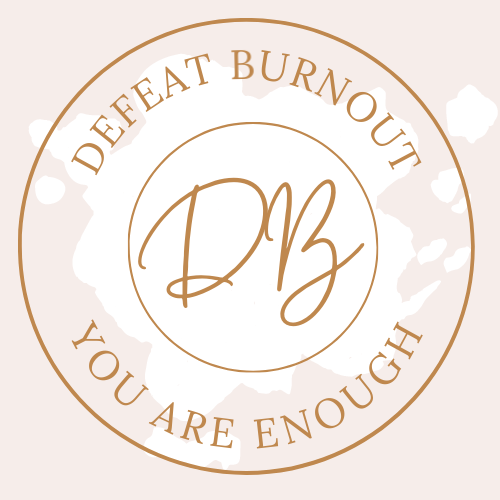Burnout is a serious health condition that describes physical and emotional exhaustion, with a host of other symptoms. The earlier in the burnout cycle that you identify you are on the path to burnout, the sooner you can stop it in its tracks. In this article, we’ll explore how to recover from a burnout from the perspective of someone who is experiencing initial warning signs, through to more serious cases
No matter where you are in the burnout cycle as you read this article, have confidence that you will come out the other side. You are worthy; you are enough.
If you’d like personal support to navigate burnout, I offer a range of 1:1 coaching options, self-study courses and free resources – read to the end of the article for the links.
I am not medically trained, and this article does not constitute medical advice. If you are experiencing a severe health condition, then you should consult a medical professional.
Table of Contents
What is burnout?
Before we get into the methods for recovering from burnout, let’s start by defining the condition. The leading researcher in this field is Christina Maslach. She defines burnout as:
a psychological syndrome of emotional exhaustion, depersonalisation, and reduced personal accomplishments can occur among individuals who work with other people in some capacity.
For a detailed overview of burnout symptoms, see my article ‘What is work burnout?‘. According to Maslach, the symptoms fall into three categories:
- physical and emotional exhaustion
- cynicism and detachment
- feelings of ineffectiveness and lack of accomplishment.

Burnout can lead to serious mental health conditions
Over time, and left untreated, the condition can lead to serious mental health issues such as depression. At its worst, burnout can make you feel like you have nothing to live for and that you can’t go on. Please listen to your body and do not let it escalate to this stage. If you are experiencing serious mental health complications, please reach out to a medical professional for help. There is no shame in this. Asking for help when we need it is a sign of strength.
I needed the support of a physiatrist when I burned out in 2017. Without his help, I would have struggled to understand what was happening to me and why. I’d missed all the signs and did not realise what was happening until my body shut down and I was in a state of depression. I share my story to raise awareness of this prevalent and debilitating condition so as many people as possible can avoid the dark depths of a severe burnout, or come out the other side as quickly as possible if they are already there.
Why does burnout happen?
The causes of burnout are often work-related. People are working long hours daily under high levels of stress. Without an outlet for that stress and healthy self-care methods, pressure can build-up over time and lead to burnout. However, burnout is not always solely driven by high workloads or just in the workplace. It can also come from pressures in family life, from your loved ones, and challenging situations where you feel a lack of control.
You may experience burnout if you are in situations for extended periods where your values are out of sync with how you are forced to act. If you’re working hard in a job or for others and don’t feel valued for your contribution, that can also cause burnout over time, as can a lack of support and perceived fairness.
For an in-depth discussion on the causes of burnout, you can read What Triggers Burnout?
How to recover from burnout
Step 1: Recognition
The first step to your recovery is recognising that you are experiencing some signs of burnout. These could be very mild at the start of the process and therefore easy to miss. You may be later in the process and have signs that you can’t miss, such as not being able to get out of bed.
The sooner we recognise the signs, the easier it is to come out of the other side. By the time I noticed, I was so deep into utter burnout that I had to rest completely and was unable to work for six months.
Step 2: Prioritise your self-care
The metaphor of putting on your oxygen mask first is very relevant to burnout. When you lack full health and energy, it becomes impossible to give to others without harming yourself. However, that to-do list in the office and at home may seem like the most important tasks to be getting on with, in the long term you’ll be far more effective if you optimise your self-care first. So much of this we already know; the hard part is doing it consistently.
One of the things that helped me as a type-A personality who likes to achieve continually is to set myself a weekday checklist for the self-care steps I needed to achieve. You can see the exact one I use, and download a blank template for yourself HERE.
The steps to an energy-giving and life-saving self-care regime include:
- Sufficient sleep – studies suggest between 7-9 hours. I lived on 4 hours of sleep a night for years, and this one shift has been life-changing for me.
- Hydrate well – there are different views on how much fluid you need to take on daily, and it also depends on the level of exercise you do and the climate you spend time in. Start with the NHS’s recommended level of 6 to 8 glasses a day and tweak from there based on how you feel.
- Eat a variety of nutritious meals.
- Get some exercise in each day, ideally with some outdoor activity each week. Your workout doesn’t need to be vigorous. A simple walk at lunchtime can make all the difference.
- Schedule in some ‘you time’ to relax, ideally each day, but at least weekly. You could pamper yourself with a nice bath or curl up with a favourite book – whatever recharges you.
Step 3: Take control of your work situation
If your job is the leading course of your burnout, then it’s time to make some changes. I recognise how difficult this can feel. However, until we take control and set boundaries at work, we teach people to treat us in a way that leads us to feel exhausted and not perform at our best.
Some of the strategies that you can try to gain greater balance at work include:
- Regular breaks away from your screen and desk throughout the day. Set a vibrating alarm on your phone to make sure that you do this. A quick stretch, walk to the water cooler, or walk in nature at lunchtime can make all the difference to your mental health. You’ll come back to your desk, feeling more energised to work through the next tasks.
- Setting boundaries on when work starts and ends each day. If we are not intentional, work can begin as soon as we open our eyes and look at our devices, carrying straight through to a final email check before we turn out the lights. We never allow our brains to switch off, and it impacts our sleep and wellbeing. You also teach your colleagues to expect immediate replies from you. Start to be more disciplined with start and end times to your work, especially if you are too busy. Work expands to take the time we give it and unless you protect your time, no one else will. It’s easy to become the person that everyone goes to when there’s extra work to be done.
- Prioritise like crazy! A long to-do list can be overwhelming. Spend some time mapping out which tasks are important and urgent and need to be done first, vs ones that are important and not urgent (schedule them for another day), ones that are not important but urgent (delegate them), and ones that aren’t important or urgent (bin them!) This model is known as the Eisenhower Matrix.
- Practice saying no. In the workplace, it can be tough to say no when we are already overworked. You may worry that it will impact your performance rating or that your manager will overlook you for promotion. However, the reality is that if you are consistently not setting expectations on what’s an appropriate workload and doing too much, you’ll be less productive, less happy, and perform worse than others. Setting boundaries and saying no is a form of self-respect.
- Ask for support if you are overloaded. Many of us like to create the impression that we are super people who can get everything done single-handedly. If you are drowning in tasks and unrealistic deadlines, then it’s time to reach out for support. Your manager and team may not have an appreciation for just how much is on your plate. Give them the chance to step in. In the process, you may create opportunities for others to take on new challenges and develop new skills in the process.
- Create a tranquil working space where possible. If you have some control over where you work, try to find an area where you can think and focus without interruptions for blocks of time. If you are working from home, try to make this a separate space to where you sleep and relax. If you don’t have a separate room to work in, make sure your workspace looks different when you are not working; it can be as simple as tidying your work equipment out of sight when you stop for the day, so you don’t have a temptation to just checking your emails one last time.
Step 4: Talk about it
A critical part of your burnout recovery is to talk about your experiences. This help could be in a formal support group, or with a trusted friend or colleague. By talking about burnout, you are more able to recognise and take seriously what is happening and why.
We are social beings, so the more we can connect with others, the less burnout will push us into detachment and isolation.
For me, talking with a therapist was the best option. I was so ill that I needed support from someone who could help me understand and process what I was experiencing. Connecting with people who had seen it all before gave me a little comfort that it was not the end of the world and that I would get better. The one thing I looked for, and struggled to find, was a network of people like me who had experienced burnout and recovered. A group that I could talk to about the non-medical topics. That’s what motivated me to train as a coach and create defeatburnout.com; I can now be that person for others.
Step 5: Let the emotions out
From my own experiences and a variety of research, I believe that one of the key reasons burnout can have such a devastating impact is that we bottle up our emotions to control ourselves in the office and in front of other people. Over time this can lead to physical symptoms.
If you’ve had a lot of work-related stress one week, you may congratulate yourself for getting through it. However, it’s likely that pressure is still in your body and needs releasing. That release could come in various forms:
- Having a good cry in a safe space.
- Doing some boxing to push out the anger and aggression built up from the week. It can also help to visualise the thing or person that has left you feeling this way and imagine transferring the emotions out of yourself into the thing you are visualising.
- Getting a comforting hug from someone you care about and imagining all the stress flowing away, out of your body.
Step 6: Celebrate every bit of progress
If you are an overachiever, avoid trying to overachieve in your burnout recovery by setting yourself lots of ambitious goals and then beating yourself up for not achieving them immediately. Recognise that it will take time to get back to the best version of yourself, but that there are many things to celebrate along the way.
Start by celebrating each time you do something positive for your burnout recovery, such as:
- Stopping work at the time you intended
- Taking some time for you
- Taking a walk in the park
- Going to bed earlier.
You may find it helpful to write down these successes in a beautiful journal that you can look at if you are having a challenging day and feel like you are not making progress in your recovery. You’ll be amazed by how much you have already achieved.
Step 7: Make time to check-in with yourself
The long-term fix for burnout is developing a level of self-awareness that means you identify the signs that you are out of balance before they become more serious emotional exhaustion symptoms.
You could take 5 minutes every day (ideally) or every week to check in on how you feel. It can be therapeutic to write this down in a journal. That process will help you identify why some days feel good, and others you lack motivation.
Burnout recovery is not always linear, and that’s ok
One of the painful lessons that I learned while recovering from burnout is that recovery is not always linear. I’d take significant steps forward, then get overconfident and push myself too soon, and take a few steps back again.
In hindsight, this was merely me learning what my body needed. I was always moving forward in my recovery, just not always as quickly as I wanted to. About a year on from when burnout hit me hard, I came across this quote from an unknown author who really spoke to me:
One day it just clicks. You realise what’s important and what isn’t. You learn to care less about what other people think of you and more about what you think of yourself. You realise how far you’ve come and you remember when you thought things were such a mess and that you would never recover. And you smile. You smile because you are truly proud of yourself and the person you’ve fought to become.
That sums up my experience of recovering from burnout perfectly. You can recover, and you are enough.
Conclusion: recovering from burnout can give you an entirely new perspective
When you are in the midst of burnout, it can feel like your life is over, and you’re going to be broken forever. That just isn’t true. Your body is just giving you feedback that your life is out of balance with what you need.
Burnout is a chance to reset how you live, to get to know yourself better, and to create a happier, healthier, and more fulfilling life along the way.
If you are battling burnout right now, you are not on your own. For additional support to collapse time and get more support with your recovery, you can:
- Book one of my luxury 1:1 coaching and mentoring packages
- Take the self-study Burnout Recovery Masterclass
- Sign up to our email list
- Contact me at emma@defeatburnout.com for details of our upcoming events and other ways to work with me





Really helpful article. Thank you for sharing your personal experiences.
Thank you for taking the time to comment Marianne. If I can help you in any way with your journey, please drop me a line at emma@defeatburnout.com.